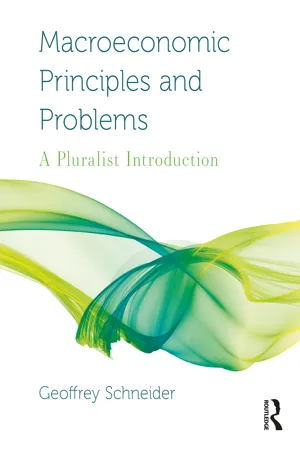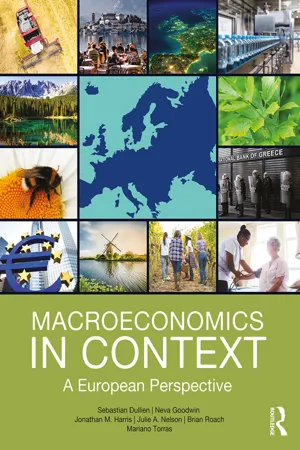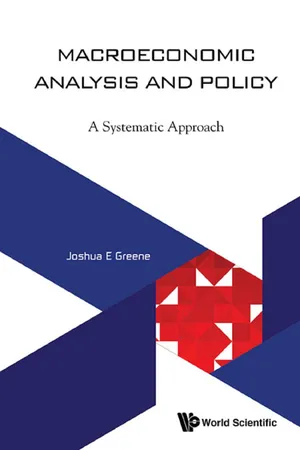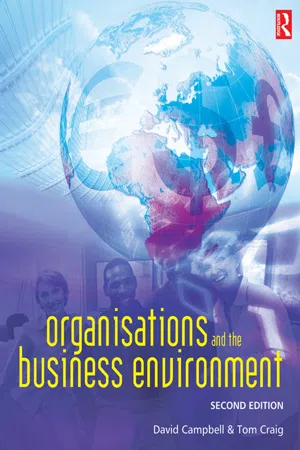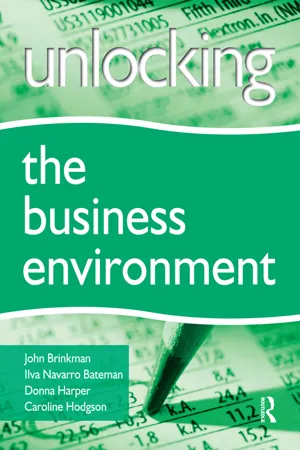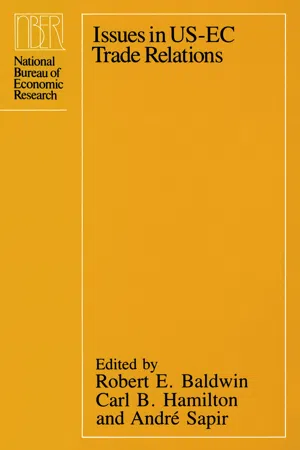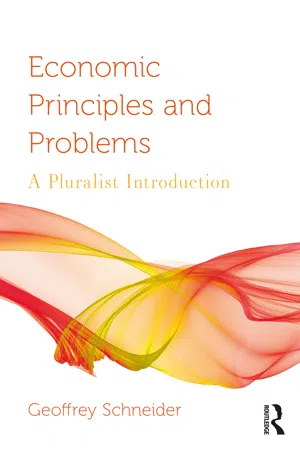Economics
Macroeconomic Issues
Macroeconomic issues refer to the broad economic concerns that affect an entire economy, such as inflation, unemployment, economic growth, and fiscal and monetary policies. These issues are studied and analyzed to understand their impact on the overall health and stability of an economy, and to develop policies that can address them effectively.
Written by Perlego with AI-assistance
Related key terms
Related key terms
1 of 4
Related key terms
1 of 3
7 Key excerpts on "Macroeconomic Issues"
- eBook - ePub
Macroeconomic Principles and Problems
A Pluralist Introduction
- Geoffrey Schneider(Author)
- 2022(Publication Date)
- Routledge(Publisher)
PART III Macroeconomic Issues and problems DOI: 10.4324/9780429399350-10 This section provides a broad overview of the current state of macroeconomics and the key issues that macroeconomists are studying. Chapter 8 introduces modern macroeconomics and the importance of understanding aggregate economics as a different way of thinking than microeconomics. The chapter also describes the evolution of macroeconomic policy, beginning with the Keynesian consensus of the 1950s and 1960s, the return of laissez-faire approaches from 1980 to 2007, and the switch back to Keynesian economics after the financial crisis of 2008-2010 and the coronavirus recession of 2020. Key macroeconomic topics are discussed, including the business cycle, stabilization policy, economic growth, and financial markets. Chapter 9 discusses economic well-being. There are debates over the most important goals for an economic system and what data we should use to measure, describe, and analyze the macroeconomy. Traditionally, economists used real gross domestic product (real GDP) to measure the health of the economy. However, political economists and some mainstream economists argue that other measures, such as the OECD Better Life Index, the genuine progress indicator, and the United Nations Human Development Index are better measures of welfare due to the limitations of GDP. Some prefer to use measures of happiness. Subsequently, in Chapter 10, we turn to the major macroeconomic market failures: Unemployment and price instability. The chapter describes the different types of unemployment and the problems that occur due to unemployment. Then, the chapter discusses inflation and deflation and the problems they can cause for the macroeconomy - eBook - ePub
Macroeconomics in Context
A European Perspective
- Sebastian Dullien, Neva Goodwin, Jonathan Harris, Julie Nelson, Brian Roach, Mariano Torras(Authors)
- 2017(Publication Date)
- Routledge(Publisher)
Macroeconomic conditions also affect personal debt. If your parents have bought a house, they will be paying back loans for a number of years. The higher the prevailing real interest rates in the economy, the more costly this borrowing will be. Your own economic well-being will also be tied to global issues such as trade flows and currency exchange rates—especially if you go to work for a business that does a lot of importing or exporting or you send money back to relatives in a home country. If you are lucky, all these factors will fall in your favor. If you are not … well, then you can join the chorus blaming “the economy” for your troubles.unemployment: a situation in which people seek a paying job but cannot obtain oneinflation: a rise in the general level of pricesSuch Macroeconomic Issues are considered “short run”—economists refer to them as having to do with macroeconomic “fluctuations.” Sometimes unemployment is high, and sometimes it is low, and the same goes for inflation, interest rates, trade deficits, and exchange rates.Other Macroeconomic Issues have to do with the long run. Can you expect your standard of living 20 years from now, or the standard of living of your children, to be higher or lower than what you enjoy now? Are you living in a society where all people have a chance to develop themselves, or are extremes of wealth and poverty becoming more pronounced over time? What is the supply of natural resources used in production processes, and what is the quality of those resources? What other social and environmental factors affect the ability of the economy to prosper or threaten its success?Macroeconomics seeks to explain an especially interesting phenomenon: the fact that bad things can often happen on a national or global level even though virtually no individual or microeconomic-level organization wants or intends - eBook - ePub
Macroeconomic Analysis and Policy
A Systematic Approach
- Joshua E Greene(Author)
- 2017(Publication Date)
- WSPC(Publisher)
Chapter 1INTRODUCTION TO MACROECONOMIC ACCOUNTS, ANALYSIS, AND RELATED POLICY ISSUES
Macroeconomics is the study of an entire economy. Macroeconomics assumes the existence of many individual economic sectors and the markets governing them. Thus, the focus is on the behavior of the economy as a whole — the aggregate of all the markets for goods and services, as well as the impact of the public sector (government and government-owned entities, called public or state-owned enterprises) and the rest of the world on the economy. Studying an entire economy requires conceiving of aggregate demand — the total demand for goods and services in the economy — and aggregate supply — the total amount of goods and services made available for sale in the economy. In equilibrium, aggregate demand and aggregate supply should be equal. In practice, aggregate demand and supply can differ, generating a variety of macroeconomic conditions, including short- to medium-term fluctuations in an economy, called business cycles.Macroeconomic analysis involves studying an economy’s main components. These include - eBook - ePub
- Tom Craig, David Campbell(Authors)
- 2012(Publication Date)
- Routledge(Publisher)
It examines the national and international aspects of economics and how national economic policies affect individual households, consumers and businesses. Macro-economics is also concerned with the ways in which the state manages the economy by using the range of economic ‘levers’ or ‘weapons’ at its disposal (Figure 9.1). Figure 9.1 Different branches of economics. Micro- and macro-economics – an imperfect metaphor If you look at a picture from a great painter, you can appreciate it on two levels. From a distance you can enjoy the totality of the painting, its spatial arrangements, the configurations of the figures, the blends of light and shade, the colours, and so on. If you then approach the painting and examine it in detail, possibly with a magnifying glass, you can analyse the intricate individual brush strokes, the textures and the individual colour amalgams. Whilst we mainly see the big picture, we can readily appreciate this would not exist without the intricate, painstaking work invested in each stroke. The quality of the painting comprises both levels of appreciation. We can view macro-economics as our view of the total painting and micro-economics as our examination of the intricate strokes and textures. Macro-economics concerns the effects of thousands or even millions of individual micro-economic decisions. The Macro-Economic ‘Environment' Given that macro-economics concerns the ‘big picture’ of economics, it is reasonable to ask what the components of the macro-economic environment are inasmuch as they can affect business (which, after all, is the subject of this book). The macro-economic environment includes such national and international concerns as: levels of tax levied by the government; levels of public expenditure (i.e. spending by the state); the price of borrowing money (i.e - eBook - ePub
- John Brinkman(Author)
- 2014(Publication Date)
- Routledge(Publisher)
The chapter began by outlining the importance of the economy to individual nations and the effect of the economy on individuals, organisations and governments. The term economy was explained and the three main types of economy were outlined. The focus of the chapter on the macroeconomic environmental factors was made clear. Key economic influences were introduced including international influences, national trade cycles and local economic effects. In addition to these, economic influences, key economic factors such as inflation, interest rates, exchange rates and levels of unemployment were examined in some detail. The chapter concluded by pointing out some emerging ethical and international issues around the macroeconomic environment.Key IdeasSome of the main points covered in this chapter are listed below. If you feel unsure about any of them, then revisit the appropriate section. If you would like some additional reading on the topic, try the books listed below in recommended reading.What do we mean by the term economy?•The economy is the system used within a community for the allocation of scarce resources.•A nation’s economy can be defined as the organisation within that country where decisions are made about what to produce, for whom to produce and how to produce.Key economic influences•There are three main types of economy: free market, centrally planned and mixed.•International factors such as the global economy, trading blocs, trading bodies and international financial institutions can influence a domestic economy.•The national economy is important to individuals, organisations and the government. For example, in terms of employment, income (individuals) opportunity to produce goods and services (organisations) and level of taxes collected, good standards of living for citizens (governments).•The national economy refers to the total economic activity in the country’s economy over a defined period of time – usually 12 months.• - eBook - ePub
- Robert E. Baldwin, Carl B. Hamilton, André Sapir, Robert E. Baldwin, Carl B. Hamilton, André Sapir(Authors)
- 2009(Publication Date)
- University of Chicago Press(Publisher)
VII Interaction between the Macroeconomic Environment and Trade IssuesPassage contains an image 13 Macroeconomic Policy and Trade Performance: International Implications of U.S. Budget Deficits
Rachel McCulloch*13.1 IntroductionAs the trade ministers of 74 nations gathered in Punta del Este in September 1986 to launch the new “Uruguay Round” of multilateral negotiations, the U.S. Department of Commerce released numbers documenting still another record deficit in the nation’s trade accounts. Even after a spectacular decline in the dollar relative to other major currencies, the U.S. merchandise trade deficit for 1986 was anticipated to reach $170 billion, a figure almost beyond imagining just a few years earlier. This seemingly inexorable growth of the trade imbalance intensified domestic political pressure for new protection, exacerbated trade disputes between the United States and its trading partners, and dimmed prospects for new multilateral action to maintain open international markets.Despite ongoing discussion of the U.S. “competitiveness problem,” most economic analysts and policymakers had long since agreed that macroeconomic developments in the United States and abroad were the root cause of the huge trade imbalance. However, recognition of the key role of macroeconomic forces in no way simplified policy choices on trade. Macroeconomic conditions continued to disrupt normal trading relationships, and the burden of dealing with the resulting imbalances continued to fall on those directly responsible for trade matters. Yet trade officials have little influence in determining macroeconomic policies at home—and none at all abroad. While finance ministers, central bankers, and heads of state prolonged the debate on appropriate macroeconomic remedies, the domestic political need to “do something” about trade virtually ensured new protectionist moves by the United States—and retaliatory action from trading partners. - eBook - ePub
Economic Principles and Problems
A Pluralist Introduction
- Geoffrey Schneider(Author)
- 2021(Publication Date)
- Routledge(Publisher)
There are similar divisions with respect to how economists view sustainability. Political economists see the need for substantial government efforts to address sustainability, New Keynesian economists want some intervention, and conservative laissez-faire and supply-side economists prefer less intervention.Interestingly, one of the topics economists debate extensively is how we should measure the health of the macroeconomy. Since the Great Depression, most economists tended to focus on the growth of real GDP as the best measure of the health of an economic system. However, as we will see in the next chapter, real GDP does not adequately capture many aspects of well-being, so modern economists are developing a new set of measures to reflect more accurately how the macroeconomy functions in all of its multifaceted elements.Questions for review
- List the key goals economists have identified for a macroeconomic system. Which do you think is most important? Why?
- How did Keynes demonstrate that Say’s law would not hold in recessions and that the market would not self-correct?
- Describe the evolution of post-World War II macroeconomic thinking as it relates to changes in global economies. What ideas dominated during Pax Americana? How did these ideas change with the advent of stagflation and the beginnings of neoliberal globalization? What did economists learn from the Asian financial crisis, the dot.com bubble, and the sub-prime housing bubble?
- Define each of the following economic concepts in your own words and briefly explain why the concept is important.
- Real GDP.
- Real GDP per capita.
- Unemployment rate.
- Labor force participation rate.
- Inflation rate.
- What is stagflation, and why did it prove to be difficult for mainstream Keynesian economists to cope with in the 1970s?
- Describe the efficient market hypothesis in your own words. How did this hypothesis contribute to policies to deregulate financial markets? What were some of the results of the deregulation of financial markets?
Index pages curate the most relevant extracts from our library of academic textbooks. They’ve been created using an in-house natural language model (NLM), each adding context and meaning to key research topics.
Explore more topic indexes
Explore more topic indexes
1 of 6
Explore more topic indexes
1 of 4
